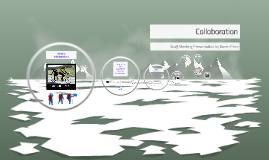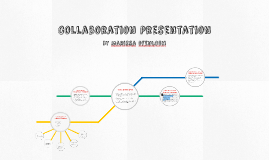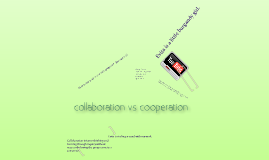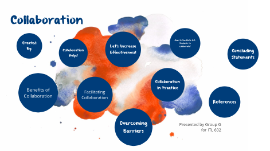Collaboration Presentation
Transcript: Engagement can be defined several ways when connected with collaboration: 1. Enjoying the line of work and who you work with 2. Confident in the school and the cause 3. Include others in decision making 4. Open-minded and accepting #4 Respect 5 Characteristics of effective collaboration Topics of discussion Characteristics of effective collaboration Ways to foster collaboration and involvement Approaches to promote school-home connections Ethical issues to consider when working with parents and families Know who you are and what you stand for Voice your thoughts and viewpoint without fear of judgement Acknowledge your own faults Accept different views and opinions Be honest to yourself and others "Coming together is a beginning. Keeping together is progress. Working together is success." - Henry Ford Collaboration Presentation 1. Commitment 2. Authenticity 3. Engagement 4. Respect 5. Positivity Personal Connections: Share who you are using a storybook or "Meet the Teacher" letter, encourage students and families to create their own storybook, conduct home visits, establish community connections, and develop "Getting to Know Your Student & Family" survey. Parent Involvement: Provide opportunities for parents to volunteer, create interactive homework, utilize parents as a support and resource, and hold student-parent led conferences. Consistency: Establish expectations for the year, daily folder routine, bi-weekly or monthly newsletters, and classroom website. Student Progress: Update parents with a weekly progress snapshot and daily behavior calendar as well as notes or phone calls of student praises and concerns. #5 Positivity #2 Authenticity Collaborative teams are a group of individuals working towards accomplishing the same goal. When challenges present themselves, team members need to be dedicated to and focused on the cause. Ethical issues to consider when working with parents & families By marissa ofenloch Develop meaningful and valued connections with students and families Provide parents with the opportunity to be a part of the learning process at school and at home Establish consistent and reliable expectations and a communication system Update parents and families on student academic and behavioral progress Partner with parents in sharing the responsibility of expert role #3 Engagement http://www.huffingtonpost.com/jennifer-twardowski/11-signs-of-a-truly-authentic-person_b_9462220.html http://centerforparentingeducation.org/library-of-articles/focus-parents/encouraging-positive-attitude-creating-positive-environment/ Amatea, Ellen. Building Culturally Responsive Family-School Relationships, 2nd Edition. Pearson Learning Solutions, 04/2016. VitalBook file. Encouraging positivity: Remove any causes of dissatisfaction Instill, "We can", or, "We will try our best!" Compliment with uplifting words Spread gratefulness or praise with a note Focus on family strengths Honor the opinions, lifestyle, beliefs, culture, skills, and experiences of others. Show respect with gratitude, encouragement, mindfulness, sincerity, and commitment. Ways to foster collaboration & Involvement Respect, preserve, and value family responsibilities, rights, culture, and traditions Uphold procedures, policies, laws, and regulations Eliminate any biases and personal prejudices Collaborate with parents and families in a professional manner Disclose relevant information to the parents only in regards to their student Be morally responsible Supplemental Resources Highly motivated and positive school-home connections increase productivity, awareness, success, curiosity, creativity, and willingness to see goals through. #1 Commitment Approaches to promote school-home connections

















